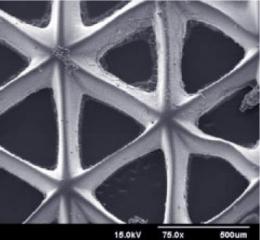Nov 16 2010
University of California, San Diego NanoEngineers won a grant from the National Institutes of Health (NIH) to develop the tools to manufacture biodegradable frames around which heart tissues – functional blood vessels included – will grow.
Developing methods for growing tissues that mimic nature's fine-grained details, including vasculature, could lead to breakthroughs in efforts to grow replacement cardiac tissues for people who have suffered a heart attack. The work could also lead to better systems for growing and studying cells, including stem cells, in the laboratory.
 University of California, San Diego, nanoengineers won a grant from the National Institutes of Health to develop the tools to manufacture biodegradable frames around which heart tissues -- functional blood vessels included -- will grow. Developing methods for growing tissues that mimic nature’s fine-grained details, including vasculature, could lead to breakthroughs in efforts to grow replacement cardiac tissues for people who have suffered a heart attack. The work could also lead to better systems for growing and studying cells, including stem cells, in the laboratory.
University of California, San Diego, nanoengineers won a grant from the National Institutes of Health to develop the tools to manufacture biodegradable frames around which heart tissues -- functional blood vessels included -- will grow. Developing methods for growing tissues that mimic nature’s fine-grained details, including vasculature, could lead to breakthroughs in efforts to grow replacement cardiac tissues for people who have suffered a heart attack. The work could also lead to better systems for growing and studying cells, including stem cells, in the laboratory.
Professor Shaochen Chen from the UC San Diego Department of NanoEngineering is the Principal Investigator on the four-year $1.5 million grant from the National Institutes of Health. The grant is funding development of the manufacturing platform necessary to produce these biodegradable frames or "scaffolds."
"We are creating biomaterials with nanostructures on the inside," said Chen. "Scientifically there are so many opportunities at the molecular level, and nanoengineering is a perfect fit for that. We expect our new biofabrication platform will yield tissues that mimic natural tissues much more closely."
One such opportunity is to add new levels of precision and functionality to the scaffolds produced by the "biofabrication platform" that Chen and his collaborators invented and have been improving over the last five years.
With the improved biofabrication platform, engineers in the Department of NanoEngineering within the UC San Diego Jacobs School of Engineering will be able to produce scaffolds with precisely designed systems of nanoscale pores and other microarchitectural details that control how cells interact with each other and with the environment.
"You need to design the pores so the cell can get nutrition and dump waste…pathways for the cell to survive in the system," explained Chen.
Source: http://berkeley.edu/